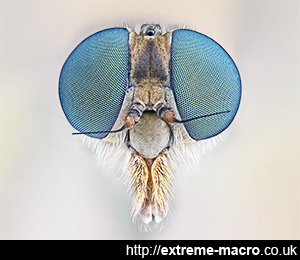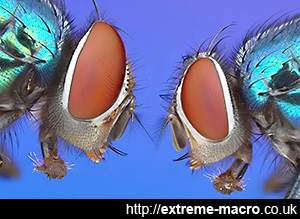Composition
by Johan J Ingles-Le Nobel
Last updated August 31, 2017
Great macro composition is a remarkably tricky thing to achieve. Although the usual rules of composition apply, I feel there are several things that need to be watched out for when doing a macro shot, and as such, perhaps not all the usual rules apply.

Photographic simplicity, focusing on the subject is a great thing. This image originally had a strong green background but I changed it to be more neutral, which has worked wonders in bringing attention back to the subject.
Simplicity
Look online for beginner macro shots and you'll often find an insect shot from above, crowded out by a mass of branches, leaves and flowers.
Vegetation is good but when the vegetation distracts from the subject of the photograph then vegetation isn't so good.
Photographic simplicity, focusing on the subject is a great thing! Remember what your subject is!
Composition Aids
Photography props, tools and aids make life easySeriously, there's nothing wrong with making things easier for yourself. I have all sorts of aids that I use and if I need a few more heck I'll just make them. Purists might say you have to do things the hard way... but the other 99% of us are a bit more practical than that.
There's nothing wrong with spraying sugar water to attract insects onto a leaf for a great shot, as long as you don't pretend that you didn't. Photography props, tools and aids make life easy.

Although there are no rules as such, for insects headshot the eyes are obviously prominent, and I find that it often pays to work a bit extra on extracting detail from and sharpening the compound eyes using photoshop masking.
Angle
There's nothing especially amazing about a shot of an insect, with the camera at head height, pointing down into where the insect is sitting.
It doesn't show a great deal of effort nor a great deal of originality.
But it's easy to make the shot interesting by getting down to the insect and shooting up towards the insect.
Know Your Subject
Photographic simplicity, focusing on the subject is a great thing! Remember what your subject is!You can save yourself a ludicrous amount of time and effort if you know your subject. I like to photograph moths but doing so during the day or even at night is like pulling hen's teeth. Close on impossible. However, if you know that a certain type of tree attracts 100s of months every evening it's in bloom and that it's easy to get a good shot when they're there, then that's the way to go.
Macro Composition Rules?
As far as I'm concerned there are really very few 'rules' for composing a good macro shot. And even those are not exactly hard and fast, as I've seen plenty of great shots that break them. But if I had to name a few desirables:
Eyes |
Make sure that the focus is nice and sharp on the eyes. Unless you're trying to show a particular part of an animal's anatomy, go for the eyes. And be harsh on yourself, if it's not quite focused on the eyes then bin the shot |
Light |
More, rather than less. Try and make sure that the darks aren't black, and use the histogram when taking the shot to make sure that there's plenty of light on there |
Subject |
Keep it simple. If you can crop it to show less distracting leaves and flowers then you probably should. If you can change your shooting angle to have a nice gradated background bokeh then you probably should. |
Related Articles




